If you’ve ever tried to grow a tree from a single seed, and failed, you’ll probably want to know how the New Hampshire State Forest Nursery manages to grow about a quarter of a million trees this way each year. The nursery, part of the New Hampshire Division of Forests and Lands, has been growing seedlings in Boscawen, just north of Concord, for over 100 years. It is a point of pride that their seedlings are grown from locally collected seeds in order to be well adapted to New Hampshire’s climate and soils. All 50 varieties of shrubs and trees leave the nursery when they are between one and four years old and less than one foot tall.
On the day of my visit, highbush cranberry berries are spinning in a washing machine-like drum. As the pulp collects on the edges of the drum, the pink lentil-shaped seeds are funneled down a chute to a waiting bucket. Scotch pine cones are tumbling and shaking in antique machines designed to shred the cones and clean the seeds. Bagged conifer seeds wait in the freezer. I follow Howard (Howie) Lewis, nursery forester at the New Hampshire State Forest Nursery, past trays of acorns, cones, and hazelnuts to his office, where I begin my education on growing trees from seed.
Lesson 1: You Need Lots of Seeds
“We don’t collect handfuls, we collect pailfuls,” explained Lewis. “If we can fill a pickup truck, we do.” Red and silver maple seeds mature in June, and crews have to be there the day they come down. “If they’re ripening and we know a big storm is coming, we’ve got to jump in the truck with our tubs and our rakes,” said Lewis. Some of the best collection locations for maples turn out to be cemeteries. “They’re clean – and trees growing in the open tend to produce more seed.”
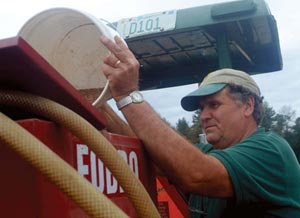
Lewis dumps conifer seeds into the drill seeder.
In a good seed year, nursery workers gather three or more bushels of maple seeds, called samaras. “We try to collect one or two years ahead,” explained seed specialist Nancy Connors. She is still planting balsam fir seeds collected in 1988, but some seeds have to be collected every year. (The shelf life of bayberry, for example, is only six to eight months.) Germination rates vary widely from species to species and year to year; Nancy Connors’ germination tests on each seed batch determine the numbers planted and their spacing in the nursery fields.
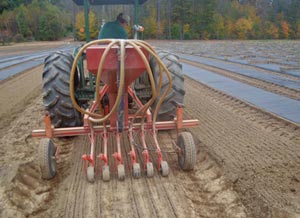
The drill seeder in action.
Lesson 2: You Can’t Grow a Pine Tree from a Pine Cone
“Conifers are a unique thing,” said Lewis, tapping a Scotch pine cone and handing me a seed. It’s just a wisp in my palm, a weightless black speck attached to a translucent wing. “Most conifers have a seed that looks like this,” he explained. “They use the wing to fly away from the mother tree.”
The seeds of most native conifers are released while the cones are still hanging in the tree. By the time the cones fall, they are fully open and empty of seeds – unless they’ve been cut and dropped by squirrels. Squirrel stacks are highly convenient for nursery staff when they go out collecting. Lewis pulls up a few photos on his computer showing Norway spruce cones in piles in the woods. “That’s a five bushel cache. We like those,” he said, explaining that the squirrels collect more than they need and that generations of squirrels use the same caching locations.
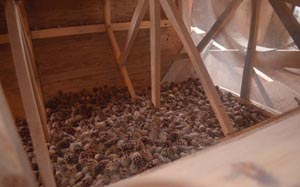
Scotch pine in the squirrel cage.
The cones of white pines ripen in August when the weather is still warm and the sap is sticky. Nursery staff will take a welcome break from weeding fifteen miles worth of seedling beds to go collecting. Old clothes are a must for this job. After a few days of collecting white pine cones, your pants stand up by themselves. After a week, you have to throw them away.
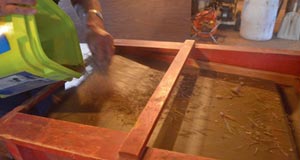
Cleaning Scotch pine on the clipper.
In late October, the crew heads to the top of Mount Kearsarge to harvest red spruce cones. “They’re all squirrel cuts,” Lewis said. But squirrels won’t cache red spruce. “They put two or three cones here and two or three cones there. You can’t tell the difference between this year’s cones and last year’s because both are brown, but this year’s have pitch on them. We crawl around on our hands and knees all day and end up with a bushel or two.” At 5,000 cones a bushel, 50 good seeds per cone, it’s still a good haul.
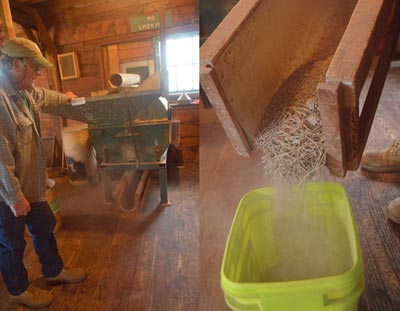
Right: Lewis at the de-winger. Left: The de-winger's output of seed, chaff, needles, and cone scales before final cleaning.
If timber is being harvested on state lands when the cones are ready for harvest, Lewis is right there with his crew as soon as the trees come down. “We are opportunists,” he said, “And we can always use more seeds.” After the cones are collected, they are air dried for a few weeks until they open. Then the seeds are extracted using antique machines with names like the squirrel cage (a tumbler), clipper cleaner, de-winger, and shaker. The resulting handful of clean seed is quite valuable. “Pure gold,” said Lewis, holding up a one-pound bag of eastern larch seeds worth close to $400.
Lesson 3: Good Acorns and Bad Acorns Look Just the Same
In a good year, you’ll find piles of acorns on the ground by early fall. They all look perfectly sound, and quite a few people gather acorns beneath their favorite trees and bring them to the nursery. Lewis is happy to receive these gifts, but he always tests the acorns for viability. Without fail, the donated acorns float in water, meaning they are no good. Turns out that squirrels, who are such helpful gatherers of conifer seeds, are no help for oak. Instead of collecting ripe acorns and placing them in convenient caches, squirrels spirit good acorns away immediately, leaving the bad ones behind.
High winds, heavy rain, or an early hard frost bring the acorns down. “That’s one you have to watch by the day,” Lewis said. “You keep an eye on the roadsides on your way to work.” At the first cue, the seed collectors go out and quickly shovel up newly fallen acorns before the squirrels get them. The nursery might plant 20,000 acorns in a year, but only one out of three acorns will make it.
Lesson 4: Guard Your Seeds
Lewis is standing by a newly planted stretch of eight thousand hazelnuts. Stamped neatly across the 300-foot length of black protective fabric are the muddy tracks of wild turkeys that came running to investigate. “If we didn’t cover them, they would be gone in one night,” Lewis said. “The next morning, it would look like a rototiller had gone through here.” As quickly as a walnut is planted, a squirrel will take it away – unless it’s securely covered.
The nursery grows about 5,000 walnut seedlings each year, planted in the middle of the field to keep them as far as possible from the mice and squirrels. “They have a pretty good nose and can sniff them out,” Lewis said. “Someone planting them in their backyard would have to cover them with a screen because nine times out of 10 the squirrels will find them. Acorns, you have a chance. Walnuts, you don’t.”
As more customers seek plantings that will serve as food for wildlife, the nursery is growing more varieties of shrubs with persistent fruits. Wildlife are drawn to the planted seeds, young seedlings, and ripening fruits on hedgerows, and this becomes a double edged sword. On the bright side, the nursery and the adjoining trails of the state forest are a great place for bird watching; on the down side, seed harvests are diminished and sometimes eaten entirely. Occasional moose tracks cross the seed beds, and nursery staff go to great lengths to protect young fir seedlings from becoming the winter browse of deer.
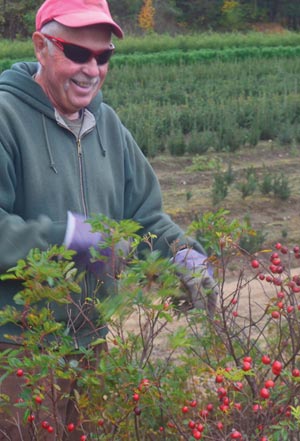
In September, Virginia rose hips are stripped from thorny branches of nursery hedgerows. New Hampshire State Forest Nursery worker Jim Viar jokingly points out, “You need gloves for this job.”
Lesson 5: Improvise
Each time the nursery adds a new tree or shrub to the catalog, Nancy Connors researches methods of seed extraction and germination. At first, winterberry holly did not germinate well. The seeds foamed like soap lather when she rinsed them and, through trial and error, she discovered that they had to be rinsed until all the lather subsides. In other words, “When you are sick of rinsing it, rinse it again.” This is part of nature’s plan. As Lewis explained, “A lot of fleshy seeds have to run through a bird’s stomach and have to be super-clean. If they germinate easily, they would compete with the parent plant.”
When Connors arrived, a slim book from the US Forest Service held all the instructions she could find. The current edition of The Woody Plant Seed Manual, weighing nine pounds and covering 1,300 taxa, still does not contain the detail she needs. This book recommends floating wild rose seeds in water and keeping those that sink. After none of her wetland rose and Rosa rugosa seeds germinated, she took a look at the floaters and the sinkers under the microscope. “I was throwing the good ones away,” she confessed with a laugh, noting the logic that when roses grow near water, their seeds will need to float away to come in contact with soil.
Lewis compares notes with people at the New York State Nursery, only to find regional differences. In New York, they have to do root cuttings of red osier dogwood; they can’t get it to germinate. In New Hampshire, they just plant the seed. “The books don’t talk about that,” he said.
When the nursery opened in 1910, they sold white pine, red pine, and white ash, primarily for reforestation. Now seedlings are purchased for songbird and other wildlife habitat, wetland restoration, stream bank control, and Christmas tree farms.
“Native shrubs have been a major part of what we’ve added in the past 15 years,” Lewis said. “We are always on the lookout for new species we can add – for example, wetland shrubs that can fill a niche for songbirds.” Maple-leaf viburnum will soon be added to the catalog, and they’re working on obtaining seed for spicebush and summersweet.
By the end of my day at the nursery I’ve heard about ridge tops, treetops, and squirrel caches that provide bushels and truckloads of cones and seeds. I’ve seen drying trays of scrub oak, hazelnut, red osier, wild raisin – entire habitats distilled into their concentrated parts. But one image sticks in my mind – a freezer packed with half a ton of conifer seeds. With a thousand pine seeds, or a million white spruce seeds, in each four-pound bag, this translates to thousands and thousands of acres of forest.
“What we do is unique,” said Lewis. “Here we have what you find in the wild – New Hampshire grown.”


